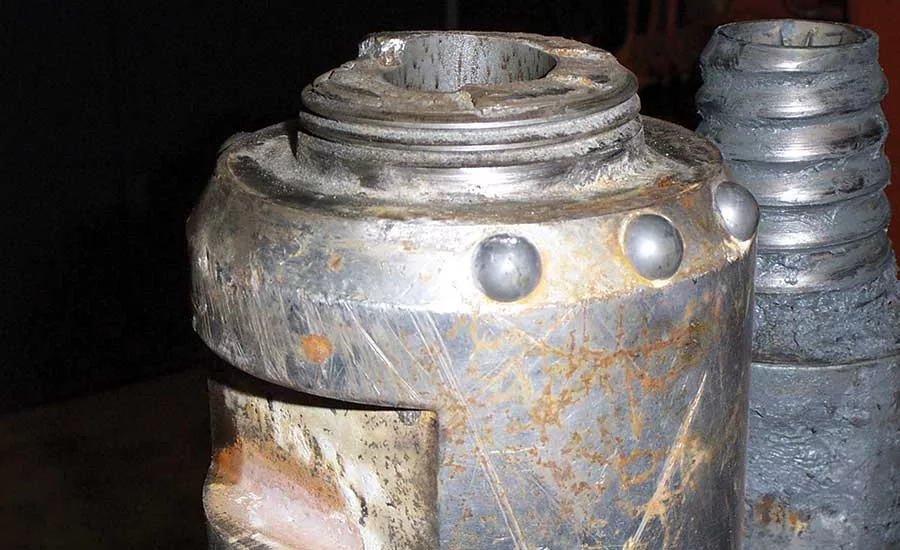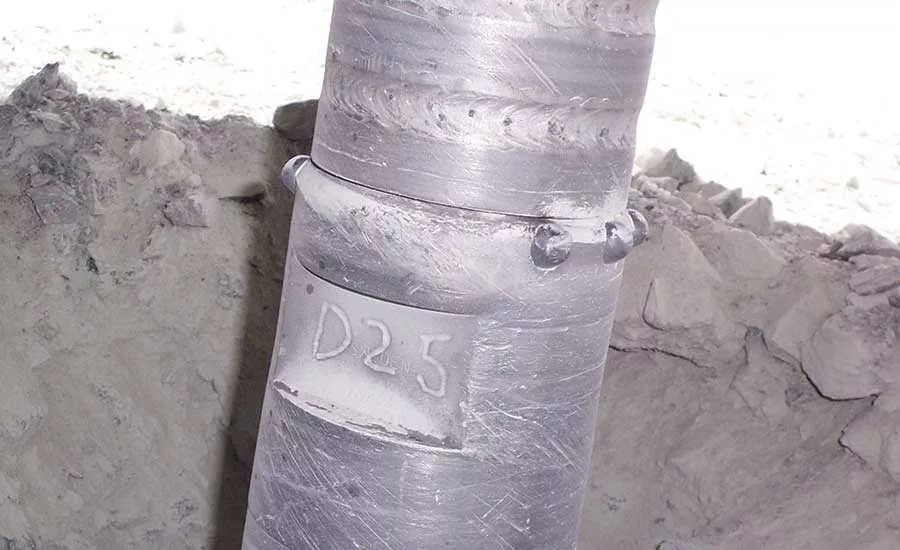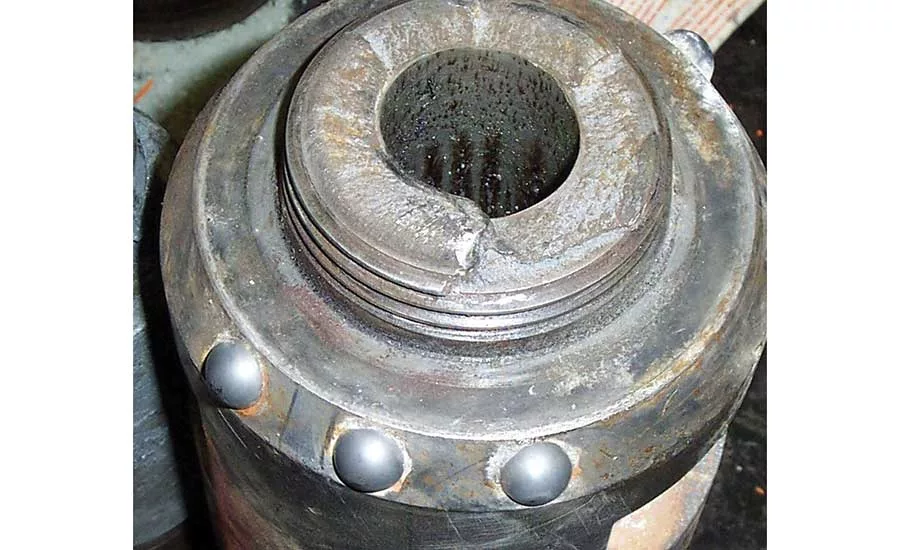Troubleshooting on the Drilling Jobsite

The broken male thread of a DTH hammer. The likely cause of this failure was that it was not properly shouldered. In the background is a Cubex-style thread.
Source: David King photos

A photo taken under the table at a jobsite in northern Ontario shows a gap between the shoulders — a likely cause of the breakage.

Spending over 40 years in the drill pipe industry has sent me on more than a couple trips to look at drill rod problems. Even the obvious extremes give us lessons. Here are two “extreme” examples.
My very first field excursion was to Philippi, West Virginia. We had sold some 4½-inch-by-15-foot flush-joint drill rods to go on a Portadrill drill rig. Shortly after receiving these, the customer called. He spoke to our manager and said the threads on one end were not the same as on the other. Our manager was quite adamant that this was impossible, and he sent me down to take a look.
I arrived, looked at the drill pipe and declared the customer was correct: 2⅞ IF pins and 3½ reg boxes. The thread protectors were the first hint. Short, sweet and done. We were wrong, and new pipe was sent. Lesson to manufacturers and suppliers: Yes, ridiculous mistakes are made by you and sometimes they get shipped.
We were manufacturing top subs for Ingersoll Rand and they had called to report thread problems on a brand new top sub. We immediately sent a new one and had the bad one shipped to the factory. When it came in, we all had a good laugh as they had never removed the 3½ reg box metal thread protector prior to trying to use it. Yes, ridiculous mistakes can be made by the rig operator and service people.
Lesson: Anything can happen, regardless of the efforts made to prevent it.
I want to turn to troubleshooting in a blasthole application. Here we can experience different problems. Blasthole drilling is a different mindset. The emphasis is on speed and straight holes, and cost per foot rules. Problems shutting down the drilling process can have long reaching effects and mine managers aren’t happy if your problem shuts down a dragline. Everything is intertwined. Blasting engineers get irritated when their shot is less effective due to crooked holes. There are pressures at every operation to be right and on time.
A major DTH hammer manufacturer called and wanted my help to solve a problem in Canada. They had two mines breaking 3½ reg pins off of their 6-inch hammers. The thinking was that it was a manufacturing situation, since it was at two locations. Perhaps it was a bad production run. The factory studied their extensive production records, and then studied the broken parts to verify the correct material. Production records indicated good threading and a check of existing stock verified it.
They wanted a new set of eyes, so I booked a flight to Timmons, Ontario — where Shania Twain grew up. It was winter, and when we pulled into the motel our SUV was outnumbered by snowmobiles.
The next day, we went to the first mine. It was a gold mine where a surface operation was running on top of an older underground operation. The drilling equipment company had the contract to supply all the drilling accessories at a set price per foot.
We stopped at the shop and I took pictures of the six or so backheads with broken pins. All had pins snapped off in the same location. I am not a metallurgist, so could not tell much from the break itself. There was also a hammer sub, and I found the box threads had some damage. I started to think about the connection between the hammer and the sub. Was it properly shouldered? Nothing breaks off the pin quicker than the threads not being shouldered. That box thread damage could prevent that shouldering.
We drove the company-leased truck to the rig where most of the problems were happening. Upon arrival, there was a report of a rail hit where the hammer bit was mashed. What was a “rail hit”? Evidently they hit an old train car rail from the underground days — an unusual danger lurking underground. The bit lost.
Once we got to the rig, I observed for about five minutes before walking up to the rig. I told the operator that his starter rod had a cracked weld on the pin end. He said it had just been put on that morning, and that he would change it out later. None of the drill steels were supplied by me so this discovery was not painful whatsoever.
They stopped the rig so we could take a closer look at the hammer, hammer sub and starter rod. The connection between the hammer and sub was below table level and it was difficult to see behind the dust curtain. But, as suspected, the connection appeared not to be shouldered. I needed a photo for confirmation, so I crawled under the table and took a couple. If you have never done this on a blasthole rig, know that dust is mighty fine. It ended up all over me. However, the photo evidence showed the gap between the shoulders, and I was happy and confident I’d found the problem.
The rep (I can’t remember his name …) was a younger guy, and we got along well. We were driving from the mine to the shop in a good mood on a four-lane highway. All of a sudden, there was a “clunk!” sound, and we felt a jolt. We looked at each other with the same “what was that?” look, as I pointed at our rear driver’s side wheel rolling by us as we slowed. The aluminum rim had broken. After we finished laughing, we got out to find the leasing company manager had been behind us. He gave us a lift back to the shop. Now, that is service.
I was driven by the regional manager to the second mine. We drove late in the day and you could see snowmobile traffic on its own skinny roadways running alongside the highway. They even had their own traffic signs. Snowmobiling is a large tourist attraction here. After dark, I caught a glimpse of a moose tracks (actual tracks by a moose in the snow, and not my favorite ice cream flavor) along the roadway. I even saw one moose.
By the time we got to the mine site the next day, they had solved their problems at that location. When starting a hole, the operator runs the hammer down a couple of feet, and then runs it up and down quickly to form a cone above the hole, sometimes called collaring. They were breaking pins here. They discovered their centralizers were so worn that the hammer could lead off in their formation, causing stress at the connection. They put new sleeves in the centralizers and the problem went away.
Sometimes in mining, they will use hard surfacing to extend the life of their drill rods. In this case, both the drill pipe and subs had hard metal applied. The subs were about coated with it. It did extend the life of the drill sub and help protect the bottom of the drill rod. But I believe it also led to this problem, at least in a way. Without this hard metal or even with less, could that sub with the damaged box have been discarded before the damage got that bad?
Why did no one see the connection between the sub and hammer was not shouldered? Likely because when you pulled up the hammer through the table, the non-split deck bushing rides on top of the hammer. This hides that connection, as the hammer was 5⅜-inches OD and the drill rods were 4½-inch. The only way to see it without making the effort to lift that centralizer was to look behind the deck curtain.
The other aspect was when these pins broke off in those subs, that broken piece was removed and the sub sent back into service, evidently without inspection for damage. Box damage is hard to see. I typically use my bare hand to gently feel the threads. Not the best, as the usual indicator of thread damage is bloody fingers.
The deck bushings have replaceable sleeves, but they need to be inspected for wear. This is sometimes a forgotten maintenance issue, but it can create expensive problems.
We drove back to Timmons, and I flew out the next day. Mission accomplished. Both problems were solved and, to top it off, I got to see and take a photo a competitor’s drill rod with a cracked weld. The worn deck bushing was a new one for me. Broken pins tend to be about shouldering and makeup torque when isolated to a certain area of the drill string. But we also saw that a sudden lead off can also cause this.
I have seen a lot of options utilized to extend the life of the drill pipe. Some are effective and some are expensive overkill. Some require additional inspections you may not normally do. Extending the life of the exterior will expose the interior to additional wear. If you read one of my previous articles, you know that sometimes solving one problem can create a problem someplace else. We need to be aware of this, and make adjustments for it.
Looking for a reprint of this article?
From high-res PDFs to custom plaques, order your copy today!




